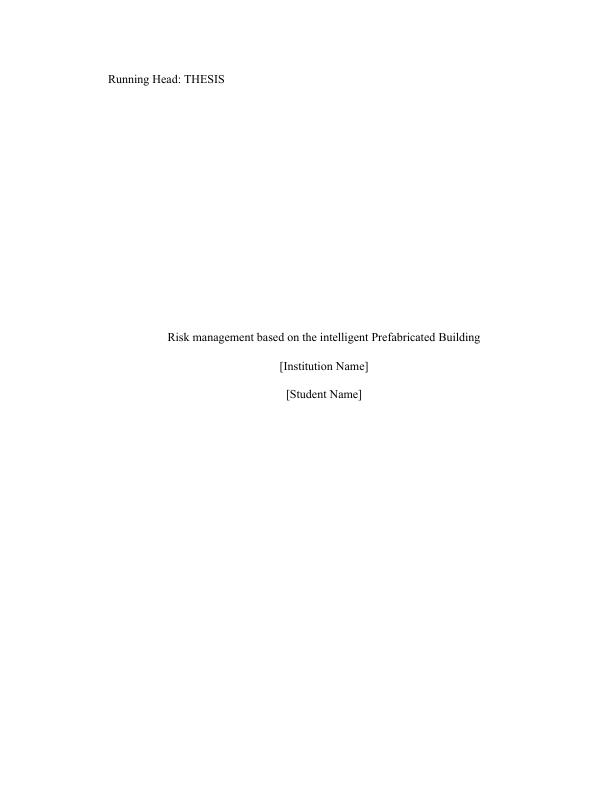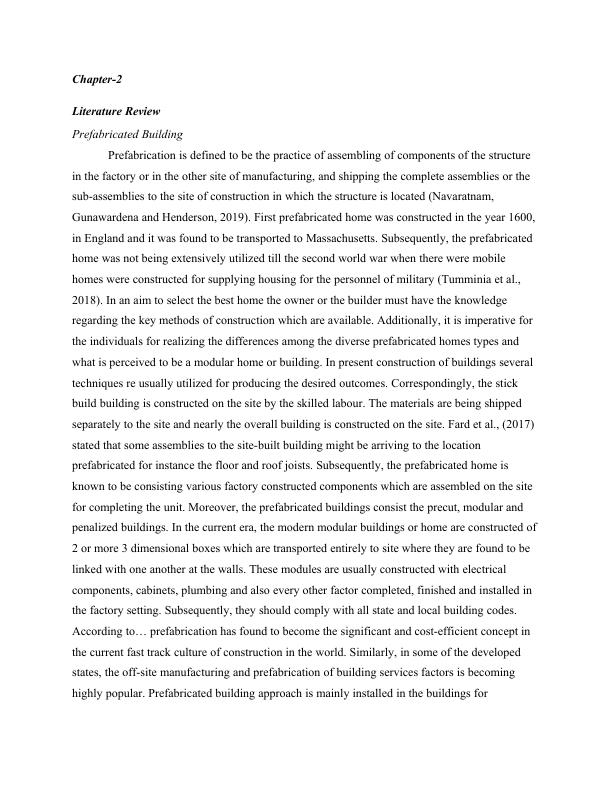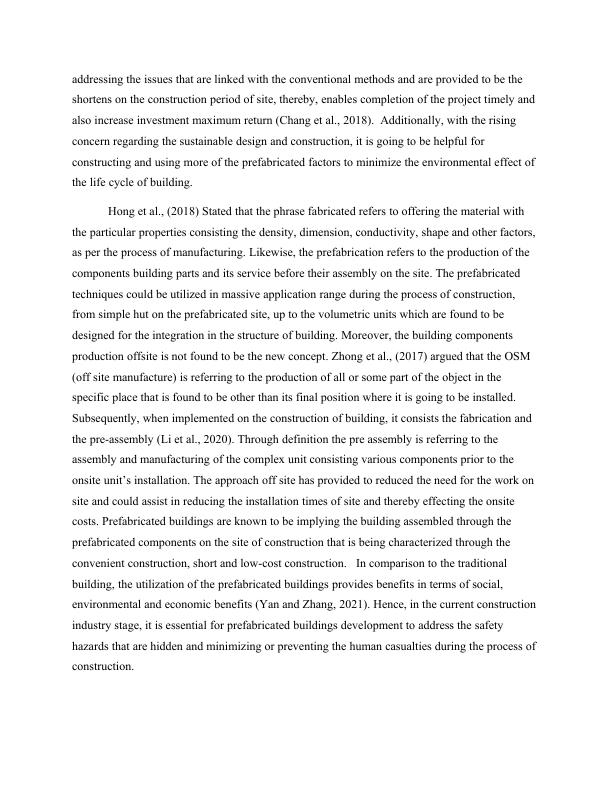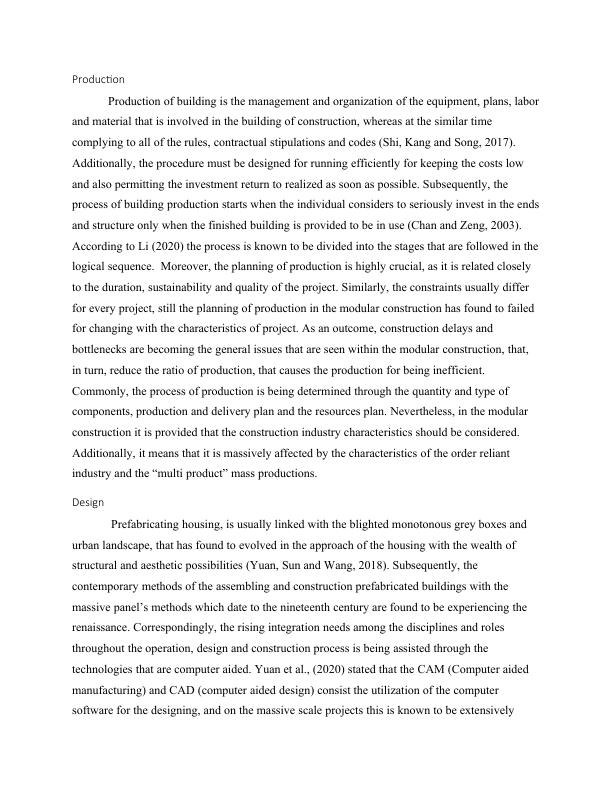Risk management based on the intelligent Prefabricated Building Literature Review 2022
Added on 2022-04-02
12 Pages4516 Words12 Views
Running Head: THESIS
Risk management based on the intelligent Prefabricated Building
[Institution Name]
[Student Name]
Risk management based on the intelligent Prefabricated Building
[Institution Name]
[Student Name]

Chapter-2
Literature Review
Prefabricated Building
Prefabrication is defined to be the practice of assembling of components of the structure
in the factory or in the other site of manufacturing, and shipping the complete assemblies or the
sub-assemblies to the site of construction in which the structure is located (Navaratnam,
Gunawardena and Henderson, 2019). First prefabricated home was constructed in the year 1600,
in England and it was found to be transported to Massachusetts. Subsequently, the prefabricated
home was not being extensively utilized till the second world war when there were mobile
homes were constructed for supplying housing for the personnel of military (Tumminia et al.,
2018). In an aim to select the best home the owner or the builder must have the knowledge
regarding the key methods of construction which are available. Additionally, it is imperative for
the individuals for realizing the differences among the diverse prefabricated homes types and
what is perceived to be a modular home or building. In present construction of buildings several
techniques re usually utilized for producing the desired outcomes. Correspondingly, the stick
build building is constructed on the site by the skilled labour. The materials are being shipped
separately to the site and nearly the overall building is constructed on the site. Fard et al., (2017)
stated that some assemblies to the site-built building might be arriving to the location
prefabricated for instance the floor and roof joists. Subsequently, the prefabricated home is
known to be consisting various factory constructed components which are assembled on the site
for completing the unit. Moreover, the prefabricated buildings consist the precut, modular and
penalized buildings. In the current era, the modern modular buildings or home are constructed of
2 or more 3 dimensional boxes which are transported entirely to site where they are found to be
linked with one another at the walls. These modules are usually constructed with electrical
components, cabinets, plumbing and also every other factor completed, finished and installed in
the factory setting. Subsequently, they should comply with all state and local building codes.
According to... prefabrication has found to become the significant and cost-efficient concept in
the current fast track culture of construction in the world. Similarly, in some of the developed
states, the off-site manufacturing and prefabrication of building services factors is becoming
highly popular. Prefabricated building approach is mainly installed in the buildings for
Literature Review
Prefabricated Building
Prefabrication is defined to be the practice of assembling of components of the structure
in the factory or in the other site of manufacturing, and shipping the complete assemblies or the
sub-assemblies to the site of construction in which the structure is located (Navaratnam,
Gunawardena and Henderson, 2019). First prefabricated home was constructed in the year 1600,
in England and it was found to be transported to Massachusetts. Subsequently, the prefabricated
home was not being extensively utilized till the second world war when there were mobile
homes were constructed for supplying housing for the personnel of military (Tumminia et al.,
2018). In an aim to select the best home the owner or the builder must have the knowledge
regarding the key methods of construction which are available. Additionally, it is imperative for
the individuals for realizing the differences among the diverse prefabricated homes types and
what is perceived to be a modular home or building. In present construction of buildings several
techniques re usually utilized for producing the desired outcomes. Correspondingly, the stick
build building is constructed on the site by the skilled labour. The materials are being shipped
separately to the site and nearly the overall building is constructed on the site. Fard et al., (2017)
stated that some assemblies to the site-built building might be arriving to the location
prefabricated for instance the floor and roof joists. Subsequently, the prefabricated home is
known to be consisting various factory constructed components which are assembled on the site
for completing the unit. Moreover, the prefabricated buildings consist the precut, modular and
penalized buildings. In the current era, the modern modular buildings or home are constructed of
2 or more 3 dimensional boxes which are transported entirely to site where they are found to be
linked with one another at the walls. These modules are usually constructed with electrical
components, cabinets, plumbing and also every other factor completed, finished and installed in
the factory setting. Subsequently, they should comply with all state and local building codes.
According to... prefabrication has found to become the significant and cost-efficient concept in
the current fast track culture of construction in the world. Similarly, in some of the developed
states, the off-site manufacturing and prefabrication of building services factors is becoming
highly popular. Prefabricated building approach is mainly installed in the buildings for

addressing the issues that are linked with the conventional methods and are provided to be the
shortens on the construction period of site, thereby, enables completion of the project timely and
also increase investment maximum return (Chang et al., 2018). Additionally, with the rising
concern regarding the sustainable design and construction, it is going to be helpful for
constructing and using more of the prefabricated factors to minimize the environmental effect of
the life cycle of building.
Hong et al., (2018) Stated that the phrase fabricated refers to offering the material with
the particular properties consisting the density, dimension, conductivity, shape and other factors,
as per the process of manufacturing. Likewise, the prefabrication refers to the production of the
components building parts and its service before their assembly on the site. The prefabricated
techniques could be utilized in massive application range during the process of construction,
from simple hut on the prefabricated site, up to the volumetric units which are found to be
designed for the integration in the structure of building. Moreover, the building components
production offsite is not found to be the new concept. Zhong et al., (2017) argued that the OSM
(off site manufacture) is referring to the production of all or some part of the object in the
specific place that is found to be other than its final position where it is going to be installed.
Subsequently, when implemented on the construction of building, it consists the fabrication and
the pre-assembly (Li et al., 2020). Through definition the pre assembly is referring to the
assembly and manufacturing of the complex unit consisting various components prior to the
onsite unit’s installation. The approach off site has provided to reduced the need for the work on
site and could assist in reducing the installation times of site and thereby effecting the onsite
costs. Prefabricated buildings are known to be implying the building assembled through the
prefabricated components on the site of construction that is being characterized through the
convenient construction, short and low-cost construction. In comparison to the traditional
building, the utilization of the prefabricated buildings provides benefits in terms of social,
environmental and economic benefits (Yan and Zhang, 2021). Hence, in the current construction
industry stage, it is essential for prefabricated buildings development to address the safety
hazards that are hidden and minimizing or preventing the human casualties during the process of
construction.
shortens on the construction period of site, thereby, enables completion of the project timely and
also increase investment maximum return (Chang et al., 2018). Additionally, with the rising
concern regarding the sustainable design and construction, it is going to be helpful for
constructing and using more of the prefabricated factors to minimize the environmental effect of
the life cycle of building.
Hong et al., (2018) Stated that the phrase fabricated refers to offering the material with
the particular properties consisting the density, dimension, conductivity, shape and other factors,
as per the process of manufacturing. Likewise, the prefabrication refers to the production of the
components building parts and its service before their assembly on the site. The prefabricated
techniques could be utilized in massive application range during the process of construction,
from simple hut on the prefabricated site, up to the volumetric units which are found to be
designed for the integration in the structure of building. Moreover, the building components
production offsite is not found to be the new concept. Zhong et al., (2017) argued that the OSM
(off site manufacture) is referring to the production of all or some part of the object in the
specific place that is found to be other than its final position where it is going to be installed.
Subsequently, when implemented on the construction of building, it consists the fabrication and
the pre-assembly (Li et al., 2020). Through definition the pre assembly is referring to the
assembly and manufacturing of the complex unit consisting various components prior to the
onsite unit’s installation. The approach off site has provided to reduced the need for the work on
site and could assist in reducing the installation times of site and thereby effecting the onsite
costs. Prefabricated buildings are known to be implying the building assembled through the
prefabricated components on the site of construction that is being characterized through the
convenient construction, short and low-cost construction. In comparison to the traditional
building, the utilization of the prefabricated buildings provides benefits in terms of social,
environmental and economic benefits (Yan and Zhang, 2021). Hence, in the current construction
industry stage, it is essential for prefabricated buildings development to address the safety
hazards that are hidden and minimizing or preventing the human casualties during the process of
construction.

Production
Production of building is the management and organization of the equipment, plans, labor
and material that is involved in the building of construction, whereas at the similar time
complying to all of the rules, contractual stipulations and codes (Shi, Kang and Song, 2017).
Additionally, the procedure must be designed for running efficiently for keeping the costs low
and also permitting the investment return to realized as soon as possible. Subsequently, the
process of building production starts when the individual considers to seriously invest in the ends
and structure only when the finished building is provided to be in use (Chan and Zeng, 2003).
According to Li (2020) the process is known to be divided into the stages that are followed in the
logical sequence. Moreover, the planning of production is highly crucial, as it is related closely
to the duration, sustainability and quality of the project. Similarly, the constraints usually differ
for every project, still the planning of production in the modular construction has found to failed
for changing with the characteristics of project. As an outcome, construction delays and
bottlenecks are becoming the general issues that are seen within the modular construction, that,
in turn, reduce the ratio of production, that causes the production for being inefficient.
Commonly, the process of production is being determined through the quantity and type of
components, production and delivery plan and the resources plan. Nevertheless, in the modular
construction it is provided that the construction industry characteristics should be considered.
Additionally, it means that it is massively affected by the characteristics of the order reliant
industry and the “multi product” mass productions.
Design
Prefabricating housing, is usually linked with the blighted monotonous grey boxes and
urban landscape, that has found to evolved in the approach of the housing with the wealth of
structural and aesthetic possibilities (Yuan, Sun and Wang, 2018). Subsequently, the
contemporary methods of the assembling and construction prefabricated buildings with the
massive panel’s methods which date to the nineteenth century are found to be experiencing the
renaissance. Correspondingly, the rising integration needs among the disciplines and roles
throughout the operation, design and construction process is being assisted through the
technologies that are computer aided. Yuan et al., (2020) stated that the CAM (Computer aided
manufacturing) and CAD (computer aided design) consist the utilization of the computer
software for the designing, and on the massive scale projects this is known to be extensively
Production of building is the management and organization of the equipment, plans, labor
and material that is involved in the building of construction, whereas at the similar time
complying to all of the rules, contractual stipulations and codes (Shi, Kang and Song, 2017).
Additionally, the procedure must be designed for running efficiently for keeping the costs low
and also permitting the investment return to realized as soon as possible. Subsequently, the
process of building production starts when the individual considers to seriously invest in the ends
and structure only when the finished building is provided to be in use (Chan and Zeng, 2003).
According to Li (2020) the process is known to be divided into the stages that are followed in the
logical sequence. Moreover, the planning of production is highly crucial, as it is related closely
to the duration, sustainability and quality of the project. Similarly, the constraints usually differ
for every project, still the planning of production in the modular construction has found to failed
for changing with the characteristics of project. As an outcome, construction delays and
bottlenecks are becoming the general issues that are seen within the modular construction, that,
in turn, reduce the ratio of production, that causes the production for being inefficient.
Commonly, the process of production is being determined through the quantity and type of
components, production and delivery plan and the resources plan. Nevertheless, in the modular
construction it is provided that the construction industry characteristics should be considered.
Additionally, it means that it is massively affected by the characteristics of the order reliant
industry and the “multi product” mass productions.
Design
Prefabricating housing, is usually linked with the blighted monotonous grey boxes and
urban landscape, that has found to evolved in the approach of the housing with the wealth of
structural and aesthetic possibilities (Yuan, Sun and Wang, 2018). Subsequently, the
contemporary methods of the assembling and construction prefabricated buildings with the
massive panel’s methods which date to the nineteenth century are found to be experiencing the
renaissance. Correspondingly, the rising integration needs among the disciplines and roles
throughout the operation, design and construction process is being assisted through the
technologies that are computer aided. Yuan et al., (2020) stated that the CAM (Computer aided
manufacturing) and CAD (computer aided design) consist the utilization of the computer
software for the designing, and on the massive scale projects this is known to be extensively

End of preview
Want to access all the pages? Upload your documents or become a member.
Related Documents
Modular Construction Methods Assignmentlg...
|10
|2395
|19
House No. 9 by MOS Architects: A Unique Example of Modular Designlg...
|8
|2156
|285
Major Project in Constructionlg...
|8
|1384
|242
Modular Construction: Uses, Benefits, Challenges, Theories & Strategieslg...
|2
|500
|233
Construction of Steel Structure: Prefabrication, Construction Sequence, Safety, Efficient Site Management, and Material Handlinglg...
|6
|1327
|381
Modular Construction: Advantages and Disadvantageslg...
|13
|3181
|402
